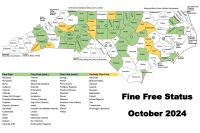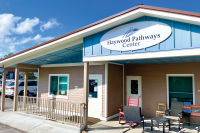Ivy covered walls
By Jim Janke
When our house was being built it became obvious that we needed to hide two 40 feet long by 10 feet high retaining walls. These walls were the first things you noticed when looking at the south side of the house, detracting from the overall landscape design. How to cover these walls quickly?
First we painted the retaining walls a darker color to make them less noticeable. Then we planted Boston ivy (Parthenocissus tricuspidata, also called ‘Japanese Creeper’). It grew moderately the first year, then took off. By the end of the third season it had completely covered both retaining walls. Boston ivy is truly a four season plant. Glossy green foliage hides the walls in spring and summer, the leaves turn a gorgeous burgundy in the fall, and the many crossing limbs with blue berries provide good winter interest.
Compared to English ivy (Hedera helix), Boston ivy is faster growing and will tolerate more sun. English ivy is evergreen; Boston ivy loses its leaves in the fall. English ivy forms small rootlets along the stem to attach to trees and banks; Boston ivy attaches to surfaces using tendrils with small, circular discs at the tips. These tendrils might damage porous wood surfaces, but will not harm cement board siding.
Plant Boston ivy in full sun to part shade. Use it as a standard ground cover, to grow up walls or trees, or to cover banks, fences, trellises or topiary frames. Boston ivy grows fast to 50 feet and is relatively disease and pest free. The only maintenance required is to cut it back every month or so to keep it contained in your desired planting area. I use a long reach pruner to keep it off the house walls.
Add plenty of organic matter to the planting hole. Plant 5 to 6 feet apart, at the same depth the plants were in the pot from the nursery. Keep moist the first year. While Boston ivy is drought tolerant, water thoroughly during dry periods, because each plant supports a huge amount of foliage. Use a balanced fertilizer each spring.
Boston ivy might be difficult to find locally. I purchased plants from Bluestone Perennials (www.bluestoneperennials.com), a company I’ve done business with for many years. Many other sources are listed on the internet.
Boston ivy grows on the walls of Wrigley Field in Chicago. If it’s hardy there, you’ll have no problem growing it in the friendly confines of the Carolina mountains.
Jim Janke is a Master Gardener Volunteer in Haywood County. For more information call the Haywood County Extension Center at 828.456.3575.





